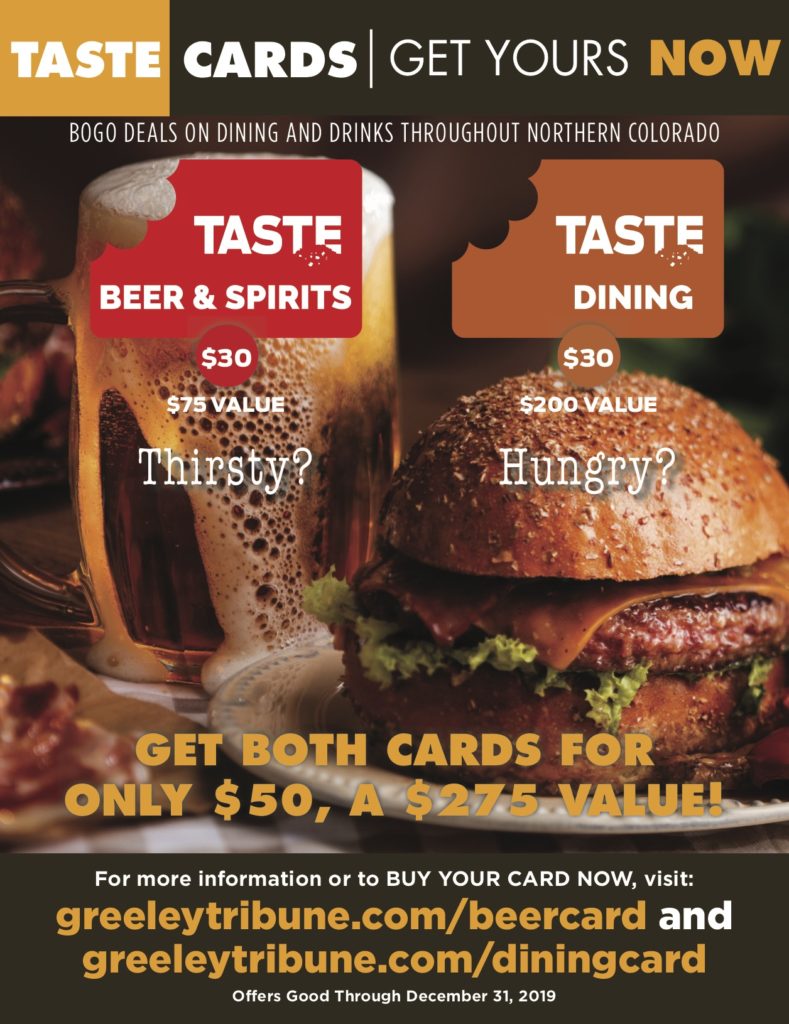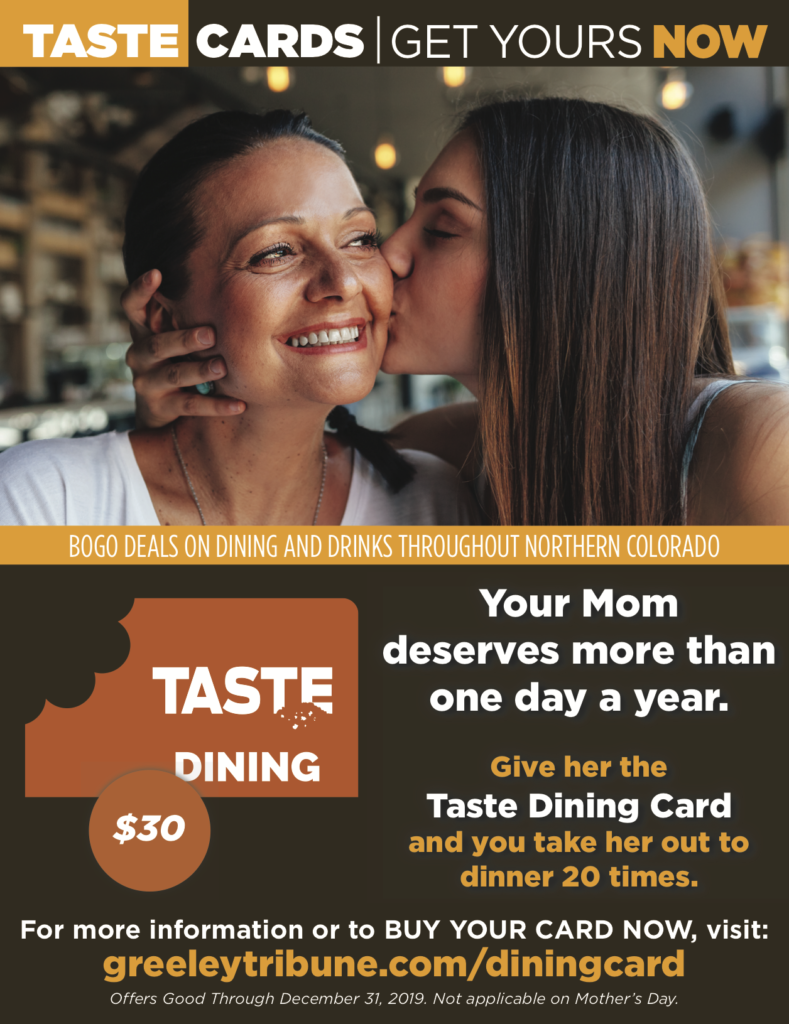How the Greeley Tribune used a “mini-publisher” team to boost revenue around food and drink discount cards
Lindsay Porter, The Greeley Tribune,This is a series on Better News to a) showcase innovative/experimental ideas that emerge from the Knight-Lenfest Newsroom Initiative and b) to share replicable tactics that benefit the news industry as a whole. This “win” comes from Lindsay Porter, magazine editor and page design chief at the Greeley Tribune in Colorado. The Tribune took part in the Poynter Institute’s Local News Innovation Program in 2018-19.
Question: What problem were you trying to solve, and why was solving the problem strategically important for your organization?
Answer: For 150 years, the Tribune has served Greeley and Weld County in Colorado. Owned by Swift Communications since 1977, the newspaper covers a growing community with strong agriculture and energy ties. Our traditional business model has relied on subscriptions and advertising. But that model is no longer enough with the digital disruption and with so many more competitors for readership and advertising dollars.
Earlier this year, the Tribune changed from a daily print publication to a four-day-a-week publication. The decline in subscriptions and advertising is challenging us to look for new revenue streams to avoid reducing the print run further or reducing staff.
As part of that initiative, in October 2018, we created a few “mini-publisher” teams, including one focused on our Go+Do audience segment — a group that enjoys going out to eat and drink.
As part of the mini-publisher model, a team’s responsibility goes beyond creating and distributing content and building audience. It also includes revenue generation, financial contribution and brand development, as outlined by Douglas K. Smith, Quentin Hope and Tim Griggs on Better News and in the “Table Stakes” manual.
The team’s leader acts like a general manager, accountable for profits and losses, audience, brand and other performance goals. That means that the team needs to span disciplines (across the newsroom and business units) and blend together all of the needed functions.
In Greeley, the Go+Do mini-publisher team consists of employees from most departments across the company: content (editorial), design, marketing, sales, finance and distribution. We meet monthly as a group to brainstorm ideas, develop strategy and assign tasks. Then individual team members work on directives with their department head and report to the mini-publisher who serves as the project manager. The Tribune also has mini-publisher teams for public safety, sports and growth and development audiences.
Specifically, the Go+Do mini-publisher team investigated how to boost revenue around its Taste food and drink discount cards. The Tribune had launched the Taste dining card and Taste beer and spirits card a few years ago, tapping into two things everyone loves — food and discounts.
We discovered sales for the Taste cards were declining, as we hadn’t added any new participating restaurants or changed our marketing strategy. The Taste cards program had a 2019 budget goal of $6,200. The Go+Do team wanted to grow the project, both in revenue and audience engagement, rather than just sustain it.
Q: How is this approach related to Table Stakes (e.g. one of the 7 Table Stakes and/or an outgrowth of the Knight-Lenfest initiative, etc.)?
A: This project is related to several Table Stakes, but especially Table Stake No. 5 (Diversify and grow the ways you earn revenue from the audiences you build) and Table Stake No. 7 (Drive audience growth and profitability from a “mini-publisher” perspective).
Q: How did you go about solving the problem?
A: The Go+Do mini-publisher team took on the Taste cards program with the goal of increasing revenue and engagement (number of units sold and number of people using the cards).
The Taste dining card program partners with 20 restaurants. The restaurants agree to provide a maximum of 1,500 buy-one, get-one deals. Most of the deals are truly buy-one, get-one free, but there are a few buy-one, get-something-at-a-lower-price deals. The Taste beer and spirits cards are similar, with 15 breweries and businesses offering buy-one, get-one deals on pints or specialty drinks.
Customers can visit each participating location only once to use the deal. Servers punch or mark their location on the card to indicate it’s been used. The only cost to the establishments is supplying the discount to our mutual customers. The restaurants don’t pay to participate or spend any marketing dollars.
In return, they are included in the Tribune’s marketing promotions for the cards. And they get customers who might not otherwise visit. (We’re working on plans to help restaurants promote the cards and remind their diners to use the cards.)

We market the cards as a way for customers to try more restaurants and save money. The only external cost to us is printing the Taste cards. Our marketing efforts include print, digital (GreeleyTribune.com), social and email campaigns. Each monthly campaign includes daily newspaper ads, at least two email blasts, online display ads and full-page ads in two of our monthly magazines. We’ve also sold Taste cards at our events. Current newspaper subscribers can buy the cards at a discount, but nearly two-thirds of our Taste card customers are non-subscribers.
The Taste cards expire at the end of the calendar year no matter when they are purchased, so buying in December or January gives customers more time to visit all the restaurants. But customers still get a great value if they purchase later in the year.
For the 2019 campaign, the Go+Do mini-publisher team surveyed past Taste card buyers to find out how they used the card, what restaurants they visited, why they didn’t get to all 20 and what restaurants they would like to see in the future. We also reminded them of the value of the card — originally selling for $20 (dining) and $15 (beer) — and asked how much they would pay for that value.
We put a $300 value on the dining card and a $75 value on the beer and spirits card. Surprisingly, more than half of the beer card participants said they would be willing to pay more for the card. The majority of the dining card buyers said they were willing to pay only $25.
We raised the price of both cards to $30, still offering a $5 discount for Tribune subscribers and offering a $10 discount for past buyers — so we could keep past buyers at $20. All new sales would be higher.
Then, we took their restaurant recommendations and approached new partners while also securing the most-visited restaurants. As a result, about half of our restaurant partners were new to the project. The beer and spirits card partners were already pretty maxed out for our area, but there were a few changes.
We reinvigorated our marketing campaign. The Taste cards typically roll out in November, in time for holiday sales. That was the main focus of the promotion. The theme or message changed monthly to appeal to different audience segments. For example, February focused on couples and date night savings with a Valentine’s theme, while May focused on Mother’s Day gifts for moms and gifts for graduates.

Q: What worked?
A: We have boosted our Taste cards revenue in the current sales cycle (November 2018 through October 2019).
In the previous sales cycle in 2018, we earned $8,050. For the 2019 sales cycle, we’ve earned $15,100. Most of this success was due to raising the sales prices of the cards. Our Go+Do mini-publisher team had set an ambitious goal of $18,200. We didn’t meet that goal, but we did surpass the company’s $6,200 goal that had been set in the budget.
The combo package sales were another success. We sold 84 combo packages. In previous years, 20 people purchased both cards, and we didn’t offer a discount for dual-card purchases or a simplified ordering process to buy both at once.
Q: What didn’t work?
A: Our new marketing initiative didn’t have much impact during our February through May sales windows. We sold a few dozen cards in those months, but our goal was to maintain 100 cards sold each month.
So, while we met our overall goals, we didn’t meet our monthly goals. We had lower spring sales. We believe that’s because even though customers still had eight-plus months to use the cards, they felt like they missed out or were getting less value since they didn’t have the full year to use the cards.
Going forward, we’ll focus on expanding spring sales and consider how to change the program to allow for longer use. We could also change the marketing to not emphasize the expiration as much.
Q: What happened that you didn’t expect?
A: When we set the marketing plan to extend past the first holiday push, the marketing team was fully on board. When we met our revenue goals by January (due to raising the sales price), the marketing team’s enthusiasm seemed to diminish, and they scaled back some of the spring plans.
Overall, I think we were focused more on the revenue goal rather than the audience goal. We didn’t grow our Taste card audience (total cards sold). In 2018, we sold 490 dining cards and 175 beer cards. By June 2019, we sold 438 dining cards and 164 beer cards. We should have focused more on audience growth with our marketing team.
Q: What would you do differently now? What did you learn?
A: If we hadn’t raised the sales price, our revenue boost still would have surpassed 2018 numbers, but not by much. Since we had made that change, and the revenue was increasing, it gave us a big cushion on the initiative to grow audience engagement.
The Go+Do mini-publisher team was handed this project late in 2018, and we scrambled to get restaurants and breweries locked in by our deadline to print and sell the Taste cards for the holidays. Originally, our goal was to launch by Black Friday, but we ended up launching the following week. We are starting much earlier for the 2020 cards and have already begun working on renewing and expanding the partner businesses.
Now that we’ve increased the revenue closer to where we want, we need to focus more on engaging with our Go+Do audience and increasing the number of units sold, regardless of the revenue goals. Northern Colorado has a rapidly expanding population so we need to tap into those newcomers to the area.
One of our ideas for 2020 is to select a few Taste ambassadors who would get free dining or beer cards. They’d use the cards and share their experiences with readers through stories, videos and social media posts.
We’d also like to have a permanent display at the participating restaurants and breweries to remind cardholders to use their discounts and help spread the word about the program.
Finally, we’d like to organize a better social media campaign. Many of our social media followers are not newspaper subscribers or in our email database, so our social media audiences on Facebook, Twitter and Instagram have great potential for growth.
Q: What advice would you give to others who try to do this?
A: Business partnerships are key. Having well-known, well-liked local restaurants and breweries as the core group attracts long-time local consumers to continue to buy the products. Adding new and smaller restaurants and breweries also keeps customers interested.
Know your market. We focused on food and drink, but there is potential for buy-one, get-one discount cards in other areas: golf, gyms/fitness centers, coffee, etc. You also wouldn’t have to start with 20 deals, but 10 should be the minimum. We’re considering launching a coffee card in 2020.